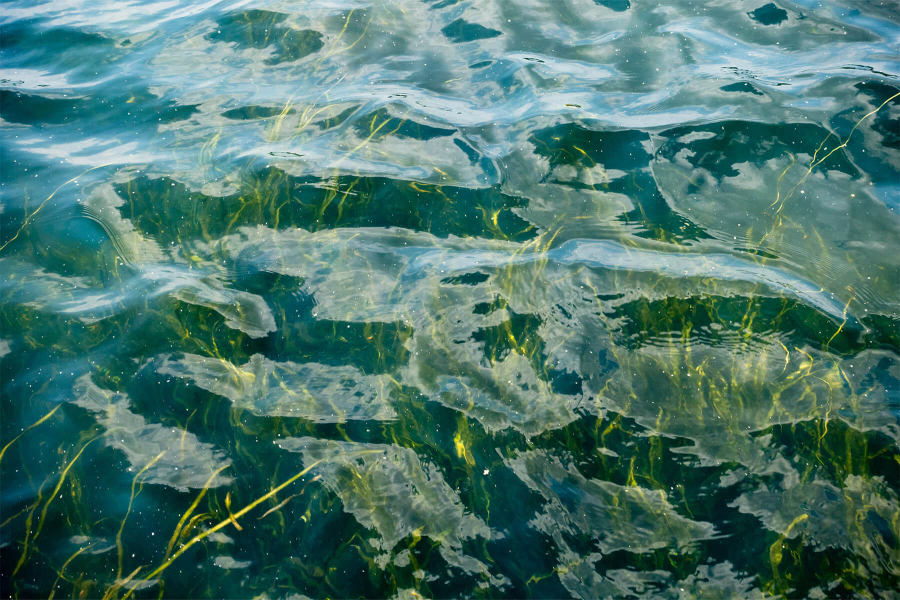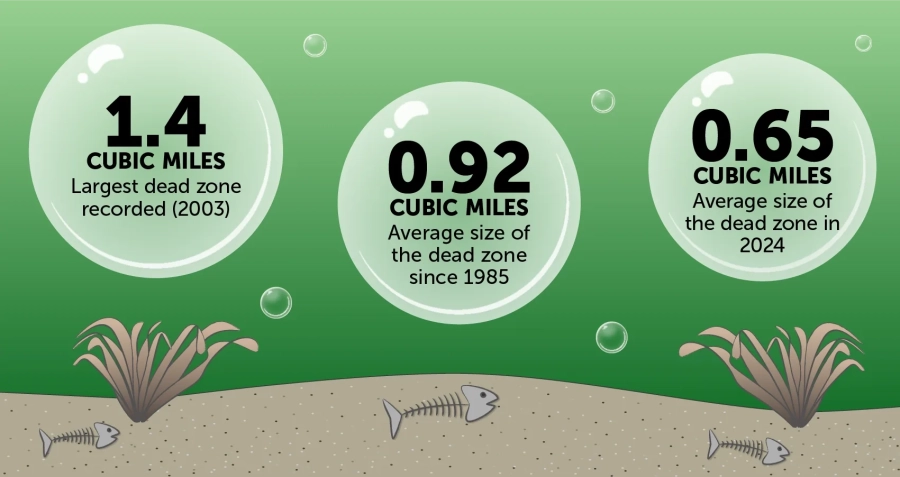The Dead Zone
When nutrient-fueled algae blooms die and decompose, the resulting low-oxygen conditions—known as “dead zones”—can suffocate underwater life and shrink available habitat.

Overview
The "dead zone" is an area of little to no oxygen that forms when excess nutrients enter the water through polluted runoff and feed naturally occurring algae. This drives the growth of algae blooms, which eventually die and decompose, removing oxygen from the surrounding waters faster than it can be replenished in the process. This creates hypoxic—or low oxygen—conditions that can suffocate marine life and shrink the habitat available to fish, crabs and other critters.
Impact on Chesapeake wildlife
Plant and animal life are often unable to survive in hypoxic environments, which is why the area is referred to as a dead zone. Marine species like fish and crabs have to move away from these areas or swim above or below them in the water column. Incidents known as “fish kills,” when dead fish wash up on shore, are often caused by dead zones in the water. Other species like oysters, which set up habitat in a specific location that cannot be moved, are particularly vulnerable to dead zones since they cannot relocate.
When and where do dead zones occur?
The dead zone is most pronounced in the deep waters of the Bay's mainstem because there is generally less oxygen toward the bottom of a body of water. Also, when algae die, they fall to the bottom of the water and remove oxygen. Dead zones most often occur during the warm summer months. This is due to the amount of rainfall that occurs during the spring, which washes excess nutrients off the land and into the water, as well as hot temperatures and weak winds in the summer which cause the dead zone to grow larger and last longer.
What is the size of the most recent dead zone?

Show image description
The infographic shows an unhealthy aquatic habitat with green, algae-filled water; brown plants; and the bones of dead fish littering the sandy bottom. Three large bubbles contain text describing different facts about the Chesapeake Bay's dead zone. The first bubble states that the largest dead zone ever recorded measured 1.4 cubic miles in size, and occurred in 2003. The second bubble states that the average size of the dead zone since 1985 is 0.92 cubic miles. And the third bubble states that the average size of the dead zone recorded in 2024 was 0.65 cubic miles.
The size of the Chesapeake Bay dead zone changes each season, depending on the amount of rainfall, temperature and wind, and the prevalence of nutrient runoff. In 2024, the Maryland Department of Natural Resources reported that the average size of the year's dead zone was .647 cubic miles, which is better than the long-term average of .921 cubic miles. Low-oxygen conditions started in May and ended in September, and were highest in early June. As the remnants of Hurricane Debby passed over the region in early August, hypoxia dramatically decreased, in part due to strong winds mixing oxygen from the surface of the Bay into its deeper waters.
How do we determine the size of the dead zone?
Throughout the year, researchers measure oxygen and nutrient levels as part of the Chesapeake Bay Monitoring Program, a Bay-wide cooperative effort involving watershed jurisdictions, several federal agencies, 10 academic institutions and over 30 scientists. Among these institutions, the Maryland Department of Natural Resources and Virginia Department of Environmental Quality conduct 8-10 monitoring cruises between May – October to keep an eye on the dead zone. The results of the monitoring cruises are posted on the Eyes on the Bay website for the Maryland portion of the Bay and the VECOS website for the Virginia portion. Estimates of river flow and nutrients entering the Bay can be accessed on the U.S. Geological Survey’s website. Scientists at the Virginia Institute of Marine Science (VIMS) also produce daily, real-time estimates of the size of the dead zone for the entire Bay.
How is climate change impacting dead zones?
Climate change has caused the Chesapeake Bay region to have more severe rainstorms and warmer average temperatures. Both rainfall and high temperatures accelerate the algae blooms that lead to dead zones. In recent years, the Bay region has had above average rainfall and temperature that have both led to above-average dead zone sizes.
What’s being done to limit dead zones?
We can reduce the size and duration of summer dead zones by reducing the amount of sediments and nutrients that enters the Chesapeake Bay. Nutrients and sediment enter the water from both point-sources, such as wastewater treatment plants, and non-point sources, such as agriculture and urban areas. Implementing pollution reducing practices in both instances can help to reduce nutrients and sediment runoff, thereby limiting dead zones.
How you can help
While you may not be able to control the weather, there are actions you can take to control the amount of nutrient pollution entering the Bay and to help slow the rise of climate change. Consider reducing the amount of pollution that can run off your property by installing a rain garden or rain barrel to capture and absorb rainfall. Use boiling water to kill weeds and other pests, rather than using chemical pesticides in your garden or yard.
